
In 1967 Robert E. McDowell wrote an article for the Louisville Magazine (June 20, 1967; pages 7-15) titled "The Wilderness Road In Jefferson County." While much of the article describes where the Wilderness Road lay in Jefferson County, Mr. McDowell also describes part of its route into Bullitt County.
With permission from Mr. McDowell's son, and the Louisville Magazine, we are reprinting most of the article here, and will include substantial parts of it in our planned Bullitt County history.
The Wilderness Road In Jefferson County
The famed trail of the pioneers through Cumberland Gap
ended at Seventh and Main Streets in Louisville.
By Robert E. McDowell
Photographs by R. N. Wathen, Jr.
MANY ENGLISH LANES haven't changed course since prehistoric times. In places they ate worn as deep as railway cuts. But American highways are as restless as the people who travel them.
Our roads shift about. They are shortened, straightened, rerouted. Sometimes whole sections are abandoned. Other sections lose their identity as they become merged with new roads. After a generation or two, no one can say with certainty just where the old road ran.
This has been the fate of the historic Wilderness Road, the most famous trail in Kentucky's history. Daniel Boone would have a harder time finding it today than he had in 1767, when he took a wrong turn on his way to Kentucky and fetched up in a blinding snowstorm somewhere near the West Virginia border.
Like Boone, we've lost the path. Except for a few stretches, we know only in a general sort of way how the pioneer trail must have run.
Beginning in Virginia, this first great overland route across the Appalachians entered Kentucky at Cumberland Gap, wound its way through the wilderness to Harrodsburg and on to the Falls of the Ohio, its western terminus. Though history fails to give him credit, George Rogers Clark was responsible for the road's being extended to Louisville. When he landed at the Falls, May 12, l778, and established his headquarters for the conquest of the Northwest, the trace was pushed out from Harrodsburg to meet him.
A great deal has been written about the eastern end of the Wilderness Road between Virginia and Harrodsburg, but its western extension to Louisville has been largely neglected. Yet it was the lifeline of General Clark's little army. Militia reinforcements and supplies, express riders, hunters and settlers straggled along the narrow, dangerous path coming from or going to the new settlements in the bluegrass or the old settlements in Virginia.
Like the rest of the path, the precise route of this western extension between Harrodsburg and the Falls seemed lost to history. Filson's map, published in 1784, shows the trail leaving Louisville by way of Sullivan's Old Station, Kuvkendahl's Mill and the Fishpools to Bullitt's Lick, thence through Bardstown to Danville. But Filson's map is full of gross errors. Bardstown wasn't on the original path, which went to Harrodsburg instead of Danville. Neither Sullivan's Old Station nor Kuykendahl's Mill were on the main road either, but on a sort of alternate path used by travelers during periods of high water.
Facts, though, are seldom lost beyond recovery. They may be buried deep, but in most cases they can be dug out.
The first break came with the discovery of an old yellowed plat in the Bullitt County Courthouse at Shepherdsville, which laid out the pioneer path from the Saltworks at Bullitt's Lick north to the Fern Creek Crossing. Hundreds of other documents in the courthouses at Shepherdsville, Louisville and Bardstown, as well as in the archives of the Filson Club, threw additional light on the problem, so that today it is possible at last to re-trace its route with considerable precision from the Falls through Louisville and Jefferson County as far as the site of the saltworks in Bullitt County.
Long before the first settlement on Corn Island in 1778, a large buffalo trace meandered southwardly from the Falls of the Ohio to Bullitt's Lick near Salt River. The pioneers claimed that buffalo could layout a road as well as any man, and it was this trail that gradually developed into the northernmost leg of the Wilderness Road.
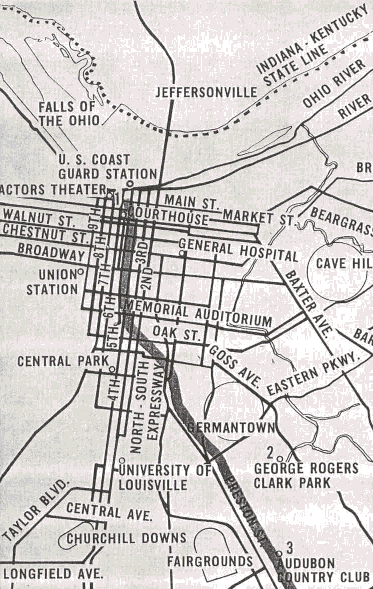
Fort Nelson (1 on map; subsequent numbers refer to location on map) , built by Richard Chenoweth in 1781 - not 1782 as the history books have it - stood on the bank of the river not far from the trace. (The Seventh Street Station, which now houses Actors Theatre of Louisville, occupies part of the site today.) The fort's gate opened directly onto present Seventh and Main.
In the early days, a small natural drain had cut a ravine in front of the fort, so that travelers after passing out through the gates went up Main Street, turning south along Sixth. As they neared Jefferson, the old trail angled across the courthouse square to Armory Place, which it followed as far south as Broadway, skirting the ponds that at one time dotted large portions of Louisville. Armory Place, formerly Center Street, is one of the last existing remnants of the Wilderness Road within the city.
The trail continued across Broadway in the middle of the block between Fifth and Sixth, then turned slightly to the southeast and angled on a long slant to the neighborhood of Fourth and St. Catherine. This segment of the trail used to be called Pope Street. Pope, though, no longer exists-at least not this Pope Street. However, if you have ever wondered why Fifth Street slants over almost to Fourth, the explanation is that it follows the path of the Wilderness Trail.
From Fourth and St. Catherine, the pioneer road turned more sharply to the southeast, cutting diagonally across the present grid of streets until it ran into Preston near Burnett. On the 1856 city map, this stretch is called Rothwell, and like Pope it has completely disappeared.
The old trail then followed the Preston Street Road southwardly, passing close to the Mulberry Hill tract (2) , where the parents of George Rogers Clark settled after the Revolution in 1785. General Clark himself made his home there for many years-his first real home in Kentucky. The big two-story log house survived until about 1917, when it was razed. But by that time no one suspected that the Wilderness Road once had passed that way.
The Mulberry Hill land was entered by Walter Cunningham in 1780; then in 1783 he amended his original entry, calling for it to be located on the trace about four or five miles from the Falls, adjoining Alexander Spotswood Dandridge on the southeast and William Preston's Poplar Level Tract on the southwest. His entry and survey are interesting because they mention the trace and the Poplar Level (3) , which was the next point of notoriety along the Wilderness Road.
Poplar levels occur fairly often in pioneer descriptions of land and would seem to have been flat rich tracts timbered with giant tulip poplar trees. This one was on the Preston Street Road neat what is now Audubon Park.
Collins mentions a pioneer station in Jefferson County before 1784 called Poplar Level, and Jillson lists it as an important early Jefferson County dwelling house established near Louisville before 1784. Both are probably mistaken. It is stated in many pioneer depositions that the road ran by the Poplar level, but none mentions a settlement or even a cabin having been located there at that early date.
The modern Poplar Level Road, which runs nearby, probably derives its name from this ancient natural feature.
Still following Preston Highway southwardly, the trail left the Poplar Level and descended gradually into the Wetwoods (4), a great dark swamp south of Louisville, which began about where Gilmore Lane runs today.
Big ponds lay in the heart of the Wetwoods. They were fed by numerous creeks: Duck Spring Branch, Greasy Creek, Blue Spring Branch, Fern Creek, Fishpool Creek, McCawley's Run, Wilson's Creek. Eventually they all joined to form Pond Creek. But it was the beaver who had made both ponds and swamp by damming these streams. The beaver soon vanished, trapped out by hunters from the Falls, but the swamp remained.
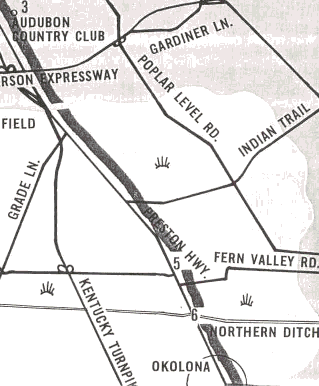
The trail, which forged straight ahead through the eastern reaches of the Wetwoods, was treacherous and nearly impassable during high water. Some of the mud holes must have seemed nearly bottomless and there are tales of oxen and mules miring to their bellies in the gooey muck.
Early in the 19th Century the road was corduroyed; that is, logs were laid across it forming a bumpy but passable bed.
About a mile and a half south of Gilmore Lane, the land rose imperceptibly to the Flat lick (5) , a place that was to gain an evil reputation in later years. Licks were generally favorite hunting grounds for the early woodsmen, because buffalo, elk and deer congregated at these spots to lick the salt-impregnated clay. William Fleming on his way to the Falls of the Ohio in 1779 wrote in his journal: ". ..we reached the Flat Lick the land round it good but low standing in water."
Sometime after Fleming's visit, a well was dug at Flat lick, probably in hopes of opening a rich vein of salt water. Instead, sulphur water of an uncommonly ripe quality was tapped. A log tavern was built there also at an early date. It was such a well-known feature that the trail, which at first had been called simply the Trace or the Road to the Saltworks, became known locally as the Flat Lick Road.
According to tradition, the tavern became even more notorious as a hangout for robbers and cutthroats who infested the road through the Wetwoods. The old rotting log cabin stood beside the highway up until a few years ago, and the chimney stones can still be seen in the field opposite Ulrich Avenue.
From Flat Lick the trail continued through the Wetwoods to Fern Creek (6) , which it forded about where Preston Highway bridges the Northern Ditch.
Once past Fern Creek, the trail grew better as the ground lifted out of the swamp. It went through modern Okolona, crossing a small branch of Fishpool Creek near the intersection of the Blue Lick Road with the highway, where a historical marker (7) commemorating the Wilderness Road has been erected.
A short distance beyond the marker and on the east side of the road is the Beech Spring (8), where George Wilson settled at an early day. Joseph Brooks, along with other pioneers, deposed that the old trace ran about 40 rods west of this spring. Thus the Wilderness Road and Preston Highway still run almost on the same track at this point.
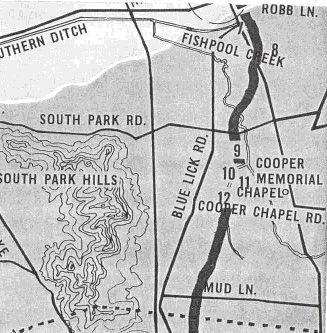
Just beyond Southern High School, though, the early trail diverged from modern Preston Highway, bearing off to the a southwest as it followed the valley of Fishpool Creek upstream. A little south of where Manslick Road now crosses the creek, another trail entered the old trace from the northeast (9).
This new trail started back on Beargrass Creek, following a buffalo path which skirted the Wetwoods on high ground. It was used principally by travelers from the Beargrass stations, but also by people from Louisville when the road straight through the swamp was impassable. Sullivan's Old Station and Kuykendahl's Mill both were on this alternate trail, which led also to Floyd's Station and eventuaily to the Falls. Today Old Shepherdsville Road follows closely a large part of it.
From the Forks, the main trail pursued a southerly route up Fishpool Creek past Moore's Spring (10) , which is still flush. Here Col. James Francis Moore settled out on the trace as early as 1783. His place became a refuge for travelers and a little community quickly sprang up as other families joined him. Though it was a.never a regular station in the sense of being picketed in, it was strong enough to stand off parties of raiding Indians. Groups often settled together this way for mutual protection against the Indians.
Fortunately Colonel Moore's cabin (11) has been preserved. It has been moved, however, to the east side of the creek and incorporated in the big white frame farmhouse owned by Mrs. John Slack. This property has remained in the same family since it was first settled, Mrs. Slack being a descendant of Colonel Moore.
Less than a mile farther up the creek are the Fishpools themselves (12) , one of the most famous camping places along the Wilderness Road.
Actually the Fishpools were springs clustered along the creek within the space of an acre. Several rose and ran a few yards, only to sink again. One or two never surfaced at all, but could be seen running at the bottom of fissures in the rock. Today a subdivision has been built over the site, and most of the fishpools have been filled in. One or two still run through, defying the subdividers' bulldozers.
Leaving the Fishpools, the trail continued up the creek in a southerly direction and crossed into present Bullitt County over a low imperceptible divide to the waters of Brooks Run.
About half-a-mile south of the Bullitt County line, a group of trees stands in an open field. They mark the Coal Bank (13), site of an old salt furnace. The original trail passed close to this furnace, where salt was made in the early 1800s. The salt water was brought in wooden pipes made from bored logs all the way from Mann's lick near present-day Fairdale, a distance of seven or eight miles.
It was cheaper to convey water to a furnace than it was to haul wood. Thus, as the furnaces consumed all the wood in their vicinity, they were moved out farther and farther from the lick to new stands of timber. This furnace, operated by Joseph A. Brooks, was built in the last days of the waning pioneer salt industry and so was the farthest out of them all.
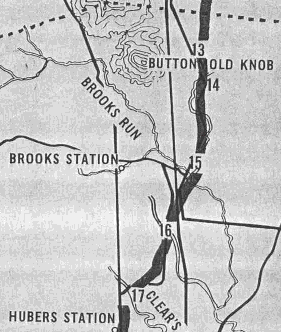
Less than half-a-mile beyond the Coal Bank, the old trail merges with the Blue Lick Road where that road crosses a small branch of Brooks Run. This is the exact spot where in 1784 Walker Daniel, Kentucky's first attorney general, and George Keightly, a merchant from Ireland, were ambushed by Indians (14). William Johnston, clerk of Jefferson County, was with them and described the ambush in a letter to the governor of Virginia.
Falls of Ohio, August 14, 1784
Sir ... This western country, perhaps, Sir, has never sustained a greater Loss, or more deep felt shock in the death of one man, than it does now in that of Walker Daniel Esquire, who with a merchant from Ireland by the name of George Keightley, on the 12th ulto. were Killed and Scalped by the Savages. As I was in Company & had nearly have shared the Same unhappy Fate; (a Ball having glanced my Breast) a concise Relation perhaps may not be amiss.
On the morning of the 12th we left Sullivan's Old Station, on our way to the Salt Works at Bullitt's Lick-We had made some considerable stay at Col. Moore's at the Fish Pools; had met numbers of people who had that day left the works, and in the Evening proceeded leisurely on unapprehensive of Danger, towards our place of evening Destination. Within five or six miles of the Salt Works, we were fired on by several Savages, to the number of Six as near as my fears, and the momentary Glance I had of them could permit me to distinguish.
The sudden and unexpected sight of a Savage stepping from behind a tree, and deliberately firing on us occasioned an Exclamation of there!! from me, who first discovered him, but the word had hardly escaped my Lips, before two or three guns more were fired on us, and the war whoops raised. The unfortunate gentlemen fell dead on the spot, having rec'd the fatal Ball thro' their hearts-the wound I rec'd was not attended with dangerous Consequences-the same Evening the dead Gent: were taken to a house half a mile further on the Road, and the day afterwards conveyed to the Saltworks for a Burial ... [from Calendar of Virginia State Papers and Other Manuscripts from January 1, 1782 to December 31, 1784, Volume III, 1883, page 605.]
The "house half a mile farther on the Road," where the bodies of Walker Daniel and George Keightley were taken, belonged to Joseph A. Brooks, who had just settled there that same year. His cabin was fortified to some extent, and wooden pickets ran down to enclose the spring.
Brooks Spring (15) , which is flowing yet, was another popular camping spot for travelers between the Falls of the Ohio and Harrodsburg. In a deposition, Squire Boone says that he passed by it with his famous brother, Daniel Boone, in 1776. He camped there again in 1779 on his return from a hunting trip to Bullitt's lick in company with William Moore and John Lee.
In 1785, the year after he moved to the spring, Joseph Brooks persuaded James Robinson to join him. The constant Indian alarms proved too unnerving for Mr, Robinson and he took his family to Bullitt's lick in 1787, where he remained until the danger had passed. Mr. Brooks, though, was made of sterner stuff and held out through it all. Such stubbornness enabled him to accumulate considerable wealth and he died peaceably of old age. He is buried about a hundred yards above the spring, where his headstone can still be seen, warning the curious with the inscription:
"Passengers as you pass by;
like you are now so once was I,
As I am now so must you be
Prepare for death and follow me."
The Wilderness Trail was not as dangerous as a modern highway, but death struck along it often enough to cause our less reckless ancestors considerable uneasiness when they had to travel it.
About a mile south of Brooks Spring, where both the old trail and the new road cross another small branch of Brooks Run, a second famous tragedy occurred. Col. John Floyd, county lieutenant of Jefferson, together with his brother, Charles, Capt. Alexander Breckinridge and two or three others, were all traveling in company to the saltworks at Bullitt's Lick. The date was April 8, 1783. The American Revolution was over and they were expecting no trouble from the Indians. Indeed John Floyd, who was an experienced Indian fighter, had on a bright scarlet cloak which he would not have worn in the woods had he suspected danger.
Just as they reached the little branch (16), they were fired on from ambush. Colonel Floyd was fatally wounded, another man shot dead on the spot. Charles' horse was hit. Seeing his brother reel in the saddle, he sprang up behind him and spurred back up the trail the way they had come.
Joseph Brooks had not yet moved out on the trace, but Colonel Moore was living at the Fishpools. Charles stopped at his cabin, and there Colonel Floyd died April 10, 1783.
They had been ambushed less than a mile from Clears Station (17) , another pioneer station farther along the trail. Actually it was far more dangerous in the vicinity of a station than it was in the deep woods, because the savages lurked around them hoping to pick off unwary settlers. The roads were not safe either, and experienced woodsmen seldom used them, but made their way through the forest.
At the site of Floyd's ambush, the old path left the present Blue Lick Road, veering off more to the southwest. It ran fairly straight past Clears Station on the east bank of Clear Run and on to the Blue Lick Gap in the knobs.
Very little is known about Clears Station. It was settled before 1783 by George Clear, who learned shortly after building his station that most of his land was covered by a better claim. Out of 1,400 acres he lost all except a little over 200. He sold this tract to Walker Daniel and moved away. The station was probably abandoned for a while, then reoccupied by the Shanklins, the Hornbecks and others. A white frame farmhouse marks the site today.
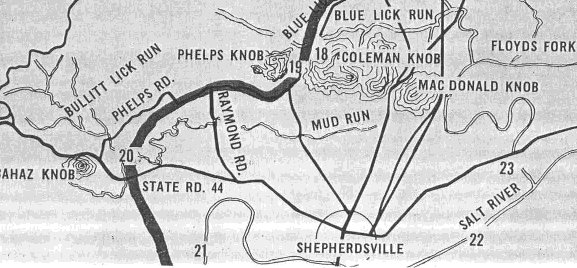
High up in the Blue Lick Gap (19), faint evidences of the old buffalo road and of the licks themselves have left telltale scars. This was a particularly treacherous spot, ideal for an ambush. During dangerous times it was avoided and a narrow path through another gap farther west was used instead.
After passing through the gap, the trail turned almost due west and followed the base of the knobs to Bullitt's Lick.
Bullitt's Lick (20) is the site of the first commercial saltworks west of the Alleghenies. The works were established in 1779, probably with the encouragement of George Rogers Clark, who needed salt desperately for his campaigns. It is not generally realized that in the wilderness salt was nearly as important as gunpowder to an army as well as to the settlers.
It was the pioneers' only preservative. They had to have it to salt down their beef and wild meat. Without it they would have starved when game was scarce. Without it the army, which travels on its belly, couldn't move. And Bullitt's Lick supplied salt for all Kentucky during the revolution.
Another spot of importance in pioneer days was Mud Garrison (21), on the bank of Salt River a half-mile above the mouth of Bullitt's Lick Run. Designed to protect the families of the salt makers at Bullitt's Lick, the station received its name from its construction-two closely parallel rows of wooden pilings with mud between the rows. The station, probably the only one in Kentucky built this way, enclosed about a half-acre with cabins built inside. It was built by Stephen Trigg, who leased the saltworks from William Christian.
The next spot of importance on the old trail was Dowdall's Station (22 ) on the Salt River, founded by John and James Dowdall and others about 1780. It was at this spot that the first ferry across the river was established. It was in running in 1781 and was at one time operated by Worden Pope, clerk of the Jefferson County Court and a member of the family for whom the now-vanished Pope Street in Louisville was named.
South of Dowdall's Station was Brashear's Station (23) , first settlement established on the Wilderness Road between Harrodsburg and the Falls of the Ohio. It was founded by William Brashear, who went out from the infant settlement at the Falls in the spring of 1779. It was also known as Froman's Station and the Salt River Garrison.
The story of the pioneer salt industry is far too long to tell here. It is enough perhaps to point out that the Wilderness Road was deflected miles out of its way in order to reach Bullitt's Lick. From the saltworks the old trail turned east toward Harrodsburg, almost doubling back on itself.
From this point also, its exact route is still largely a matter of speculation. The path, though, hasn't been lost, only forgotten. The whole length could be rediscovered. The facts are there, buried in our county courthouses and the archives many institutions, awaiting someone with the time and interest enough to dig them out.
About the Author
Robert Emmett McDowell Sr., author and historian, wrote several books about Kentucky's history -- particularly about the Civil War era. In 1962 he published City of Conflict, a chronicle of Louisville during the Civil War. Another book, Rediscovering Kentucky: A Guide for the Modern Day Explorer, was published in 1991.
McDowell's play, "Home is the Hunter," opened in 1963 at Harrodsburg, Ky. It told the story of the establishment of the first permanent settlement in Kentucky -- Ft. Harrod. Courier-Journal critic William Mootz praised the play for telling the story "unvarished by sentiment."
He was also the author of a novel, Tidewater Sprig, that was largely set in present day Bullitt County.
McDowell edited periodicals and books for the Filson Club in Louisville and he also wrote articles for the club's quarterly journal. He was a board member of the national Audubon Society, the Civil War Roundtable and the Society for Environmental Control. He died in 1995.
This is a work in progress. The web page is copyright 2016 by the Bullitt County History Museum. All rights are reserved. The textual contents of this article, and the accompanying maps are the property of Robert E. McDowell, Jr. They are provided here with permission.
No part of this page or its contents may be reprinted, reproduced, or otherwise disseminated in any format, printed or electronic, without the written permission of its owners.
If you, the reader, have an interest in any particular part of our county history, and wish to contribute to this effort, use the form on our Contact Us page to send us your comments about this, or any Bullitt County History page. We welcome your comments and suggestions. If you feel that we have misspoken at any point, please feel free to point this out to us.
The Bullitt County History Museum, a service of the Bullitt County Genealogical Society, is located in the county courthouse at 300 South Buckman Street (Highway 61) in Shepherdsville, Kentucky. The museum, along with its research room, is open 10 a.m. to 4 p.m. Monday through Friday. Saturday appointments are available by calling 502-921-0161 during our regular weekday hours. Admission is free. The museum, as part of the Bullitt County Genealogical Society, is a 501(c)3 tax exempt organization and is classified as a 509(a)2 public charity. Contributions and bequests are deductible under section 2055, 2106, or 2522 of the Internal Revenue Code. Page last modified: 12 Sep 2024 . Page URL: bullittcountyhistory.org/bchistory/wroadmcdowell.html